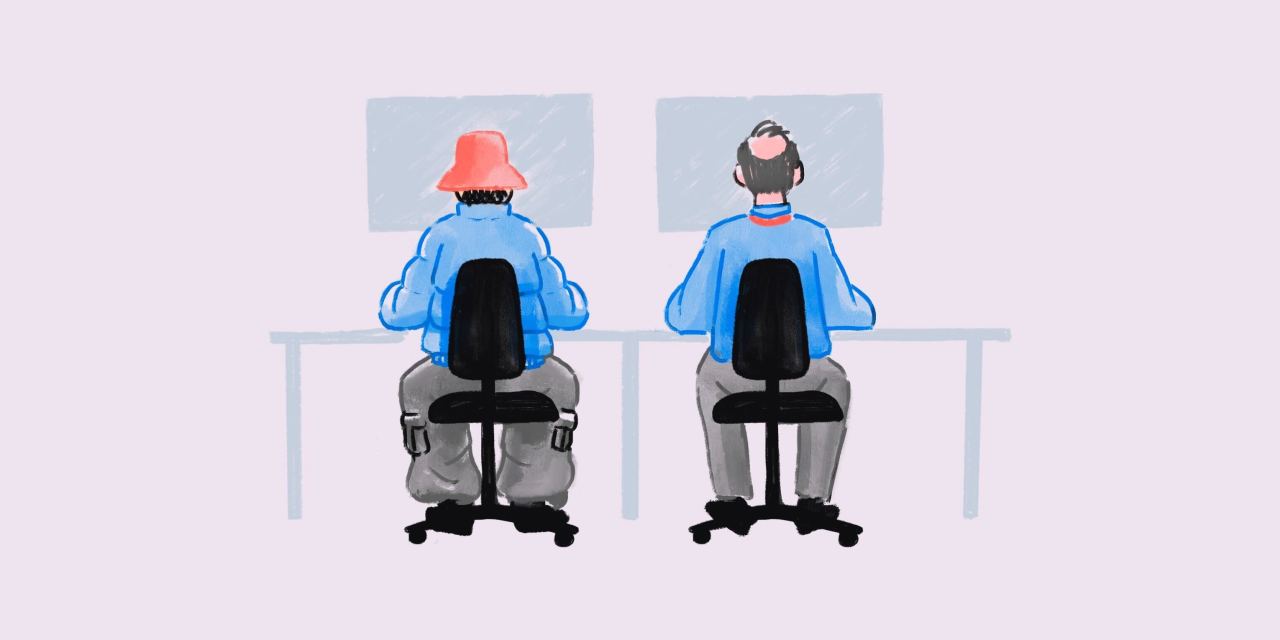Why Gen Xers are struggling with remote work

When it comes to remote work, Gen X seems to have mixed emotions.
It’s a challenge employers are faced with as they try to reshape what the future of work looks like for a range of job candidates — and what that marketability looks like for those applicants.
Consider this: in study after study, the majority of Gen Xers, born between 1965 and 1981, say they won’t look for another job if their employer required them to return to fully on-site work. It’s not the same for younger generations.
One of those surveys, jointly from Workhuman-Gallup, reports that of respondents aged 45 to 54-years-old, 38.6% said they would look for another job; 61.4% said they wouldn’t. That’s compared to 71% of 18 to 24-year-olds and 66% of 25-34-year-olds who said they would look for another job.
Gen Xers came of age professionally when corporate norms like dress codes, in-person relationship-building meetings and arriving before and staying after the boss, were how you got ahead.
“Even though our generation is seen as iconoclasts, we joined fairly traditional workforces,” said Gen Xer Karena Man, a consultant leading the data practice at Egon Zehnder and contributor to the study Different Generations, Same Ideals: What Workers of All Ages Value in their Jobs. “Our formative years were shaped by those seminal experiences of us adapting to corporate norms.”
And frankly, she said, they were happy to even have a job. Many graduated college into an economic downtown and their careers have been marked by recessions. All of that creates a sense of gratitude toward an employer and after years of working in-office, it’s a comfortable routine.
“That’s what makes returning to the office easier,” Man said. “We’re being asked to go back and are dutifully doing it.”
Communication breakdown
Unlike millennials (born between 1982 and 1997) and Gen Z (born after 1997 and just now entering the workforce), Gen Xers have had to learn and adapt to technology while already in the workforce. While the youngest generations at work communicate easily via video chats, social media and messaging apps, Gen Xers tend to feel most comfortable in-person. Some even report having a tough time reading social cues and facial expressions on virtual calls, leading to inadvertent hurt feelings and tension.
That’s a significant issue given that Microsoft recently reported the number of meetings on its Teams platform has increased by 153% globally for the average user since the start of the pandemic.
It’s something Gen Xer Jennifer Moss regularly discusses with friends.
“Burnout is a big factor for this group because it takes a lot more work to work,” said Moss, author of Unlocking Happiness at Work and The Burnout Epidemic: The Rise of Chronic Stress And How We Can Fix It. “Millennials and Gen Zers are used to a full-time relationship with tech. Gen Xers have had to adopt it quickly when we moved to remote work overnight. It’s so much quicker to stop by someone’s desk.”
Karen McCullough, an expert on bridging the generational gap on the job, said she recently spoke at a conference on managing younger generations at work, and said several Gen X attendees approached her afterwards to express their frustration in communicating with younger direct reports.
“They told me their communication style is being questioned and they’re being called insensitive,” McCullough said. “They’re being told they’re too focused on work and not focused enough on the person. They’re making people cry.”
The sandwich generation
Another factor is their stage in life — sandwiched between caring for aging parents and kids whose mental health was deeply impacted during the pandemic. That’s case-in-point for Moss, whose parents just sold their home and informed her they’re moving in until their new place is ready. Meanwhile, she’s helping her teenage daughter deal with social drama, all while her husband, chief innovation officer at the local YMCA, is struggling with work-from-home.
“We have all these increased distractions at home,” she said. “There are no boundaries.”
And while she used to love her work-from-home life as an author, everything has become more complex since her husband now works a hybrid schedule, ending the solace of her former work-from-home life.
Egon Zehnder’s Man relates. Sure, on the days she works from home for her hybrid schedule she’s a “machine” once she gets the kids off to school, not giving much thought to what she wears or stopping to eat lunch.
“I’ve returned to the office three days a week and going into an office, that is yours,” Man said. “That is my sanctuary. What I lose in productivity is made up for in what I call ‘artisanal gains.’ Face-to-face connection. Stopping and sharing physical space with someone and giving the gift of my undivided time.”
Three questions with Cali Yost, CEO of workplace consultancy FlexStrategy Group

Our most popular story last week was how this rise in ’employee nomading’ is leaving HR teams baffled about the whereabouts of some of their staff. How big a problem do you deem this to be?
Employee nomading is happening because the flexibility that currently exists in many organizations was crisis-driven. Planning and coordination guidelines that everyone works within either don’t exist or aren’t widely understood, such as: These are the states and countries within which you can and cannot work; or if you plan to work from a remote location you need to plan and coordinate where, when and how you will be working and for how long with your manager and team in advance; and when you work for X number of days from an approved location, you need to track and report those days in X system for regulatory purposes. Without those consistent guardrails, employees don’t see their “nomading” as being a problem even if HR and their teams, think it is. And you can’t blame them.
How can HR teams begin to rectify this issue?
HR can’t do this alone. HR needs to partner with the business. Clarifying consistent parameters for flexible working has to be an organization-wide recalibration process involving all teams and levels. Intentionally and thoughtfully take the best of the lessons learned over the past two and a half years about where, when and how people can work well and make necessary improvements to define the flexible way people will work next. That means if working from remote locations for extended periods has been effective for the business and for workers, then it can be as simple as defining the reporting requirements. But that same recalibration process could also find that there needs to be better coordination and planning, in addition to better reporting, which is important to know as well.
What are the stakes if they don’t take action, and what will it mean for the future of flexible working?
The stakes are the long-term sustainability of an effective flexible work model. A business has to operate within the law and abide by reporting requirements. If the way employees work doesn’t comply, then that’s a risk issue and HR has to manage it. That said, if all compliance requirements are being met then it’s about the sustainable, flexible way the job can be done to attract and retain top talent and achieve great outcomes for the business.
Random, uncoordinated “employee nomading” is just one of a number ways crisis-driven flexible work currently falls short in planning, coordination and execution. Evolving and optimizing that flexibility, with strategic intention, can resolve these issues and make the way we work next even better and more effective. — Jessica Davies.
By the numbers:
- 6 in 10 out of 4,336 U.K. employees polled believe their employer does not care about their mental well-being, and 55% said they feel pressured to hide their mental health concerns at work.
[Source of data: MHR report.] - Despite economic fears and challenges, 69% of job seekers did not consider pausing their job search due to inflation and fears of a recession.
[Source of data: Ladders data.]
What else we’ve covered
- Employees are no longer waiting a year to stick it out a job and see if things turn around. Instead, they’re walking out the door early.
- Hybrid work — and the cost-cutting benefits of reduced office real estate — is now being embraced by CFOs as they look to slash costs to offset an economic slowdown.
- Chronic insomnia is on the rise. But sleep experts stress the importance of tailored support and addressing wider workplace issues that can contribute to poor sleep.
- Millions suffer from seasonal affective disorder, and the knock-on effect to a person’s job can be substantial. But emerging tech is helping to lessen the effects of SAD.
- Leaders are grappling with unprecedented change, and that pressure is manifesting in a drop in confidence that hybrid workforces are working as they should: a mindset that is being called productivity paranoia.
- Overworking is dangerous, experts say. And yet, 68% of European human resources professionals are peddling the idea that high-performing employees work longer hours than average employees.
- With 76% of fathers wanting to work more flexibly, companies focusing just on women aren’t holistically addressing gender inequality.
- “I felt forced to take things into my own hands”: WorkLife spoke to various senior leaders who admitted to quiet firing, to understand why they have resorted to the passive-aggressive work tactic.
